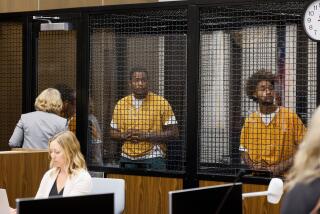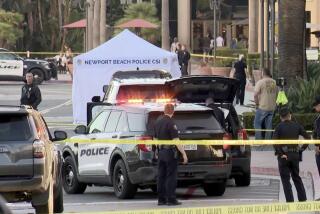Grisly Murder Dims New Zealand’s Shiny Image : Crime: Slaying of British tourist jolts nation. Cabinet minister immediately launches damage containment effort.
- Share via
WELLINGTON, New Zealand — The grisly murder of a foreign tourist has dented New Zealand’s image as a bastion of peace and tranquillity for visitors from the urban jungles of New York, London or Tokyo.
New Zealand is--by comparison to almost anywhere else--a peaceful country, but descriptions of the killing of 31-year-old English visitor Margery Hopegood have shocked its 3.5 million people.
Hopegood, whose pretty, smiling face has appeared in newspapers the world over since her death, was stabbed in a public bathroom close to a scenic riverbank where she had been whiling away a summer afternoon.
She was left to die in a pool of blood by a killer still at large.
Such incidents are rare in New Zealand, where there were just 67 murders last year, but the killing was enough to prompt Cabinet minister John Banks--who holds the police and tourism portfolios--to launch a damage containment strategy.
About 1 million foreigners visited New Zealand last year, earning the country $1.1 billion and keeping 150,000 people in employment.
“As a small, developing destination we simply can’t afford to allow visitors to be robbed and maimed,” Banks said.
“New Zealand is a most friendly country but we have our fair share of mongrels. We have nearly 1 million overseas visitors and 99.9% of them enjoy themselves but this sort of murder does gain a high profile,” he added.
New Zealand is indeed a friendly country.
It’s the sort of place where drivers help old ladies on to their buses--and wait until they are sitting down before driving off.
Banks in New Zealand have no security. Customers walk in through unlocked doors to deal with clerks who are completely unprotected.
This is a bank robber’s dream, perhaps, but thieves rarely stay at liberty for long in such a small country.
Overall reported crime rose by 6% in New Zealand in 1990, including 67 murders.
Violent crime is rare and New Zealanders were staggered last year when a deranged man went on a rampage in the tiny South Island township of Aramoana, gunning down 13 neighbors before killing himself.
New Zealand police are not armed and most people are wary of the Armed Offenders Squad, a special team allowed to carry guns.
The unspoken factor behind the changing face of New Zealand is the status of its indigenous Maori people who make up about 12% of the population.
Statistics tell part of the Maori story. Twenty percent of them are unemployed--twice as many as the white population--and 75% of Maoris earn less than $11,000 a year.
But the untold story is one which embarrasses New Zealand politicians who walk a delicate tightrope trying to appease an angry Maori community that says it has been exploited for centuries, first by British colonialists and since by New Zealand.
The shabby suburbs of Auckland, Wellington and Christchurch, inhabited chiefly by Maoris and South Pacific islanders, bear witness to a community in crisis.
Despite the Maori problem, New Zealand remains a quiet country where a burglary in a small town is talked about for days.
Crime against foreign visitors is felt deeply.
A German hitchhiker whose backpack was stolen in December could not believe his eyes when his possessions turned up again a few weeks later.
“This would not have happened in Europe. There, if you lose it then it’s gone for good,” he said.
More to Read
Sign up for Essential California
The most important California stories and recommendations in your inbox every morning.
You may occasionally receive promotional content from the Los Angeles Times.













